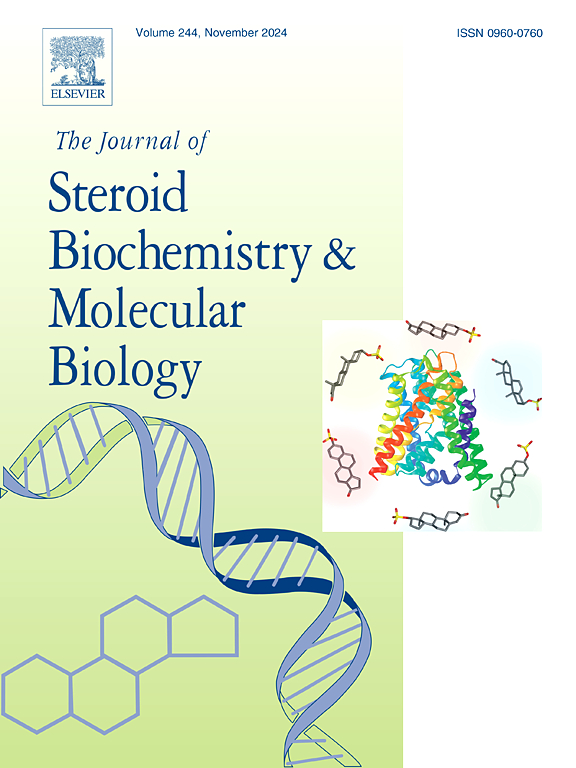Vitamin D3 (cholecalciferol) is more efficacious than Vitamin D2 (ergocalciferol) at regulating calcium absorption and bone quality in rats
IF 2.5
2区 生物学
Q3 BIOCHEMISTRY & MOLECULAR BIOLOGY
Journal of Steroid Biochemistry and Molecular Biology
Pub Date : 2025-07-23
DOI:10.1016/j.jsbmb.2025.106837
引用次数: 0
Abstract
Differential efficacy of vitamin D2 (D2) versus vitamin D3 (D3) in improving classical functions in target organs remain incompletely understood. Previous studies show contradictory results, with limited comprehensive assessment of functional and molecular outcomes across classical target organs namely intestine, bone and kidney. This study investigated the comparative effects of D2 and D3, administered independently or in combination at different dosages, on these organs using a rat model. Weanling male Sprague-Dawley rats were subjected to a depletion-repletion study design with diets containing D2, D3, combination (D2 +D3), or vitamin D deficient (VDD) diet. Our results demonstrated that vitamin D3 supplementation elevated serum 25(OH)D levels more efficiently compared to vitamin D2, while concurrent D2 administration reduced the potential of D3 to increase 25(OH)D3 levels. Both D2 and D3 maintained serum Ca and PTH in the normal range. Intestinal 45Ca absorption was higher in groups receiving D3-based diets in a dose-dependent manner. Furthermore, D3 supplementation had superior effects on bone length, width and strength compared to D2. Vitamin D3 more effectively reduced trabecular bone area in the rehabilitation phase. Additionally, the expression of genes involved in renal calcium reabsorption (Trpv5, Calbindin-D28k, Pmca1b) and vitamin D metabolism/function (Cubilin, Vdr) were significantly altered in VDD group and better corrected with D3 than D2 during rehabilitation. These findings suggest that vitamin D3 is more efficacious than vitamin D2 in improving blood levels of 25(OH)D and majority of the classical functions. Hence vitamin D3 appears to be the superior choice for both prevention and rehabilitation purposes.
维生素D3(胆钙化醇)在调节大鼠钙吸收和骨质量方面比维生素D2(麦角钙化醇)更有效
维生素D2 (D2)与维生素D3 (D3)在改善靶器官经典功能方面的不同功效尚不完全清楚。先前的研究显示出相互矛盾的结果,对肠、骨和肾等经典靶器官的功能和分子结果的综合评估有限。本研究利用大鼠模型研究了单独或联合使用不同剂量的D2和D3对这些器官的比较作用。断奶雄性sd - dawley大鼠进行了一项消耗-补充研究设计,饮食中含有D2, D3,组合(D2 +D3)或维生素D缺乏(VDD)饮食。我们的研究结果表明,与维生素D2相比,补充维生素D3更有效地提高了血清25(OH)D水平,而同时服用D2降低了D3增加25(OH)D3水平的潜力。D2和D3维持血清钙和甲状旁腺素在正常范围内。肠道45Ca吸收量在以剂量依赖性方式接受以d3为基础的饮食的组中较高。此外,与D2相比,补充D3对骨长、骨宽和骨强度的影响更大。维生素D3在康复期更有效地减少小梁骨面积。此外,VDD组参与肾钙重吸收的基因(Trpv5, calbinin - d28k, Pmca1b)和维生素D代谢/功能(Cubilin, Vdr)的表达在康复期间明显改变,D3比D2更能纠正。这些发现表明,维生素D3在改善血液中25(OH)D水平和大多数经典功能方面比维生素D2更有效。因此,维生素D3似乎是预防和康复的最佳选择。
本文章由计算机程序翻译,如有差异,请以英文原文为准。
求助全文
约1分钟内获得全文
求助全文
来源期刊
CiteScore
8.60
自引率
2.40%
发文量
113
审稿时长
46 days
期刊介绍:
The Journal of Steroid Biochemistry and Molecular Biology is devoted to new experimental and theoretical developments in areas related to steroids including vitamin D, lipids and their metabolomics. The Journal publishes a variety of contributions, including original articles, general and focused reviews, and rapid communications (brief articles of particular interest and clear novelty). Selected cutting-edge topics will be addressed in Special Issues managed by Guest Editors. Special Issues will contain both commissioned reviews and original research papers to provide comprehensive coverage of specific topics, and all submissions will undergo rigorous peer-review prior to publication.

 求助内容:
求助内容: 应助结果提醒方式:
应助结果提醒方式:


